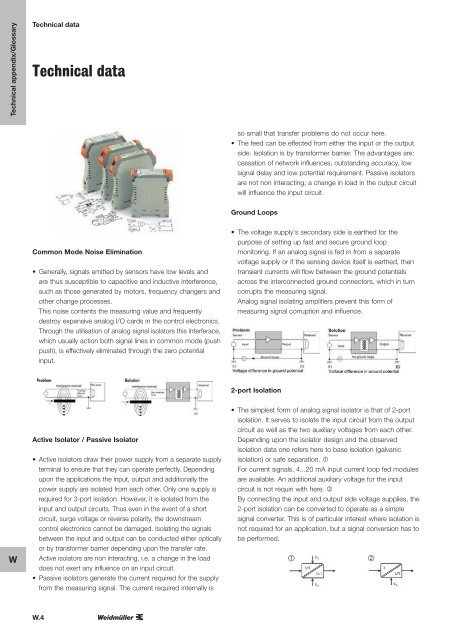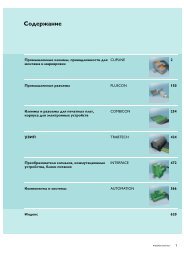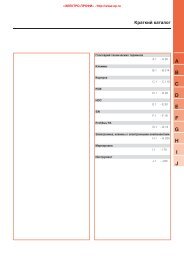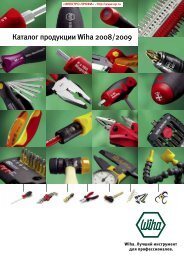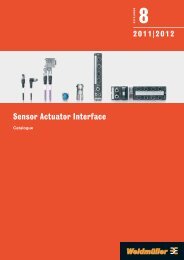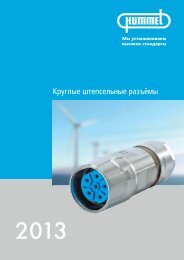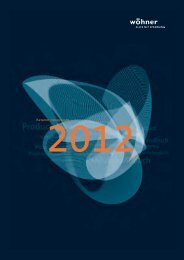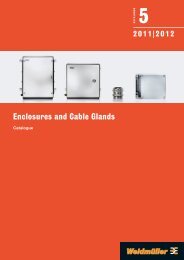ÐаÑалог Weidmuller: Electronics - Analogue Signal Conditioning
ÐаÑалог Weidmuller: Electronics - Analogue Signal Conditioning
ÐаÑалог Weidmuller: Electronics - Analogue Signal Conditioning
Create successful ePaper yourself
Turn your PDF publications into a flip-book with our unique Google optimized e-Paper software.
Technical appendix/Glossary<br />
Technical data<br />
Technical data<br />
so small that transfer problems do not occur here.<br />
• The feed can be effected from either the input or the output<br />
side. Isolation is by transformer barrier. The advantages are:<br />
cessation of network influences, outstanding accuracy, low<br />
signal delay and low potential requirement. Passive isolators<br />
are not non interacting; a change in load in the output circuit<br />
will influence the input circuit.<br />
Ground Loops<br />
Common Mode Noise Elimination<br />
• Generally, signals emitted by sensors have low levels and<br />
are thus susceptible to capacitive and inductive interference,<br />
such as those generated by motors, frequency changers and<br />
other change processes.<br />
This noise contents the measuring value and frequently<br />
destroy expensive analog I/O cards in the control electronics.<br />
Through the utilisation of analog signal isolators this interferace,<br />
which usually action both signal lines in common mode (push<br />
push), is effectively eliminated through the zero potential<br />
input.<br />
• The voltage supply‘s secondary side is earthed for the<br />
purpose of setting up fast and secure ground loop<br />
monitoring. If an analog signal is fed in from a separate<br />
voltage supply or if the sensing device itself is earthed, then<br />
transient currents will flow between the ground potentials<br />
across the interconnected ground connectors, which in turn<br />
corrupts the measuring signal.<br />
Analog signal isolating amplifiers prevent this form of<br />
measuring signal corruption and influence.<br />
2-port Isolation<br />
W<br />
Active Isolator / Passive Isolator<br />
• Active isolators draw their power supply from a separate supply<br />
terminal to ensure that they can operate perfectly. Depending<br />
upon the applications the input, output and additionally the<br />
power supply are isolated from each other. Only one supply is<br />
required for 3-port isolation. However, it is isolated from the<br />
input and output circuits. Thus even in the event of a short<br />
circuit, surge voltage or reverse polarity, the downstream<br />
control electronics cannot be damaged. Isolating the signals<br />
between the input and output can be conducted either optically<br />
or by transformer barrier depending upon the transfer rate.<br />
Active isolators are non interacting, i.e. a change in the load<br />
does not exert any influence on an input circuit.<br />
• Passive isolators generate the current required for the supply<br />
from the measuring signal. The current required internally is<br />
• The simplest form of analog signal isolator is that of 2-port<br />
isolation. It serves to isolate the input circuit from the output<br />
circuit as well as the two auxiliary voltages from each other.<br />
Depending upon the isolator design and the observed<br />
isolation data one refers here to base isolation (galvanic<br />
isolation) or safe separation. <br />
For current signals, 4...20 mA input current loop fed modules<br />
are available. An additional auxiliary voltage for the input<br />
circuit is not requin with here. <br />
By connecting the input and output side voltage supplies, the<br />
2-port isolation can be converted to operate as a simple<br />
signal converter. This is of particular interest where isolation is<br />
not required for an application, but a signal conversion has to<br />
be performed.<br />
<br />
<br />
W.4


